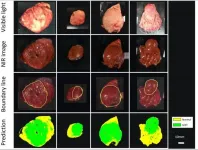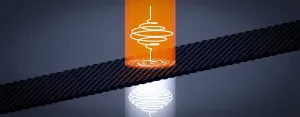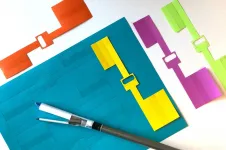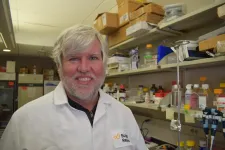A show of force: Novel polymer that toughens up and changes color upon mechanical stress
2021-02-02
(Press-News.org) A fascinating and crucial ability of biological tissue, such as muscle, is self-healing and self-strengthening in response to damage caused by external forces. Most human-made polymers, on the other hand, break irreversibly under enough mechanical stress, which makes them less useful for certain critical applications like manufacturing artificial organs. But what if we could design polymers that reacted chemically to mechanical stimuli and used this energy to enhance their properties?
This goal, which has proven to be a big challenge, is under the spotlight in the field of mechanochemistry. In a recent study published in Angewandte Chemie International Edition, a team of scientists from Tokyo Tech, Yamagata University, and Sagami Chemical Research Institute, Japan, made remarkable progress with bulk self-strengthening polymers. Professor Hideyuki Otsuka, who led the study, explains their motivation: "Furthering the development of elegant bulk systems in which a force-induced reaction causes a clear change in mechanical properties would represent a game-changing advance in mechanochemistry, polymer chemistry, and materials science." They achieved this goal by focusing on difluorenylsuccinonitrile (DFSN), a 'mechanophore' or molecule that responds to mechanical stress.
The team created segmented polyurethane polymeric chains with hard as well as soft functional segments. The soft segments contain DFSN molecules acting as their "weakest link," with both of its halves joined by a single covalent bond. The soft segments also have their side chains topped off with methacryloyl units. Upon applying mechanical stress, such as simple compression or extension, on the polymer, the DFSN molecule splits into two equal cyanofluorene (CF) radicals. These CF radicals, unlike DFSN, acquire a pink color, making it easy to visually detect mechanical damage.
Most importantly, the CF radicals react with the methacryloyl units in the side chains of other polymers, causing separate polymers to chemically hook to one another in a process known as cross-linking. This phenomenon ultimately makes the overall strength of the bulk material go up as polymers become more chemically intertwined. This chemical cross-linking effect, as the scientists proved experimentally, becomes more pronounced as more compression cycles are performed on the segmented polymer samples because more DFSN molecules are split into CF radicals.
In addition, the team created a slight variant of their segmented polymer that not only turns pink but also exhibits fluorescence under ultraviolet irradiation when mechanical force is applied to it. This functionality comes in handy when trying to more accurately quantify the extent of the damage done by mechanical stress.
The attractive properties and functionalities of the developed polymers are useful, for example, for intuitive damage detection and the creation of adaptive materials. Expressing excitement for their findings, Otsuka remarks: "We successfully developed unprecedented mechanoresponsive polymers that exhibit color change, fluorescence, and self-strengthening ability, marking the first report of force-induced cross-linking reactions achieved by simply the extension or compression of a bulk film. Our findings represent a significant advance in the fundamental research of mechanochemistry and its applications in material science."
As more mechano-responsive materials with unique functions are developed, we can expect to explore their myriad applications in various industrial and engineering fields. Be sure to keep an eye out for further progress in mechanochemistry!
INFORMATION:
[Attachments] See images for this press release:
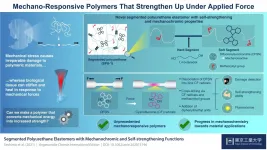
ELSE PRESS RELEASES FROM THIS DATE:
2021-02-02
Tumors can be damaging to surrounding blood vessels and tissues even if they're benign. If they're malignant, they're aggressive and sneaky, and often irrevocably damaging. In the latter case, early detection is key to treatment and recovery. But such detection can sometimes require advanced imaging technology, beyond what is available commercially today.
For instance, some tumors occur deep inside organs and tissues, covered by a mucosal layer, which makes it difficult for scientists to directly observe them with standard methods like endoscopy (which inserts a small camera into a patient's body via a thin ...
2021-02-02
Telehealth use has surged during the pandemic at clinics that serve lower-income Americans, which allowed the clinics to maintain access to care at a time when many other health care organizations saw significant declines in utilization, according to a new RAND Corporation study.
However, most of the telehealth appointments have been audio-only visits, which may pose challenges in the future if payers consider dropping reimbursement for such services.
Studying more than 500 clinic locations across California, researchers found that while overall visit volume remained stable during the pandemic, about half of primary care medical visits from March to August 2020 ...
2021-02-02
Nanoscience - Blowing the whistle on COVID-19
Collaborators at Oak Ridge National Laboratory and the University of Tennessee Health Science Center are developing a breath-sampling whistle that could make COVID-19 screening easy to do at home.
The technology incorporates a unique hydrogel material to capture aerosols from exhaled breath and preserve the samples, which could either be sent to a lab for analysis or, for a fully at-home approach, transferred to an accompanying test kit that could detect the SARS-CoV-2 virus that causes COVID-19.
"Our motivation ...
2021-02-02
Topological insulators are one of the most puzzling quantum materials - a class of materials whose electrons cooperate in surprising ways to produce unexpected properties. The edges of a TI are electron superhighways where electrons flow with no loss, ignoring any impurities or other obstacles in their path, while the bulk of the material blocks electron flow.
Scientists have studied these puzzling materials since their discovery just over a decade ago with an eye to harnessing them for things like quantum computing and information processing.
Now researchers at the Department ...
2021-02-02
Ten months into COVID-19 living, people are adapting to speaking from behind, and understanding others who are wearing, a cloth face mask, University of California, Davis, researchers suggest in a new study.
Researchers in the Department of Linguistics at UC Davis and University of Wisconsin, Milwaukee, investigated how well speech is understood from those speaking while wearing a cloth mask. Due to social distancing measures, speakers for the study consisted of individuals from the same household, who recorded sentences while face-masked and non-face-masked. The researchers tested how well a separate group ...
2021-02-02
New Haven, Conn. --A new study by Yale researchers found a significant association between the availability of hospital resources -- particularly ICU beds -- and patient mortality during the early weeks of the COVID-19 pandemic.
This was especially true at hospitals in the northeastern U.S. which were hardest hit by the first surge of patient cases, according to the study published in the Journal of Hospital Medicine.
"There is a general narrative among people in healthcare that the more resources there are, the better we can take care of patients," said lead author Dr. Alexander Janke, a Yale Emergency Scholar in the fourth year of a five-year combined residency and health services research fellowship. "This study begs ...
2021-02-02
Many surgeries today are performed via minimally invasive procedures, in which a small incision is made and miniature cameras and surgical tools are threaded through the body to remove tumors and repair damaged tissues and organs. The process results in less pain and shorter recovery times compared to open surgery.
While many procedures can be performed in this way, surgeons can face challenges at an important step in the process: the sealing of internal wounds and tears.
Taking inspiration from origami, MIT engineers have now designed a medical patch that can be folded around minimally invasive surgical tools and delivered through airways, intestines, and other narrow spaces, to patch up internal injuries. ...
2021-02-02
Interim analysis from phase 3 trial of nearly 20,000 participants suggests efficacy of two-dose regimen of the adenovirus-based vaccine is 91.6% against symptomatic COVID-19 - trial reports 16 COVID-19 cases in the vaccine group (0.1% [16/14,964) and 62 cases (1.3% [62/4,902]) in the placebo group.
No serious adverse events were deemed to be associated with vaccination, and most reported adverse events were mild, including flu-like symptoms, pain at injection site and weakness or low energy.
Sub-analysis of 2,000 adults older than 60 years suggests the vaccine is similarly effective and well tolerated in this group.
Trial is ongoing ...
2021-02-02
JUPITER, FL - A collaboration led by Scripps Research has developed a way to separate the beneficial anti-inflammatory properties of a group of steroids called glucocorticoids from some of their unwanted side-effects, through an optimization process they named "ligand class analysis."
Their process enabled them to engineer two new, drug-like compounds that show steroidal anti-inflammatory action and other specific traits. One boosts muscle and energy supply, while the other reduces risk of muscle-wasting and bone loss typical of such drugs.
Their report, titled, "Chemical systems biology ...
2021-02-02
TAMPA, Fla. -- Chimeric antigen receptor T-cell therapy, or CAR T, has been a breakthrough in the treatment of blood cancers such as acute lymphoblastic leukemia and diffuse large B-cell lymphoma. Clinical studies have shown overall response rates of more than 80% with an ongoing response of nearly 40% more than two years after therapy. However, the cellular immunotherapy doesn't work for every patient. Moffitt Cancer Center, one of the leading centers for cellular immunotherapy, is researching why some patients have a better CAR T response than others and what can be done to improve the treatment's effectiveness. In a new study ...
LAST 30 PRESS RELEASES:
[Press-News.org] A show of force: Novel polymer that toughens up and changes color upon mechanical stress

